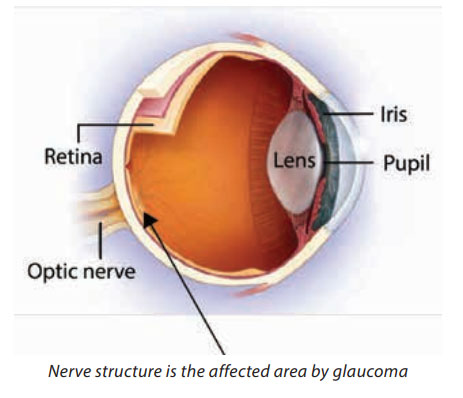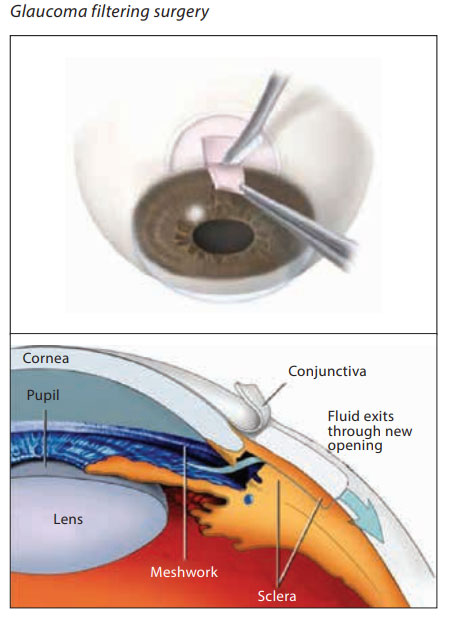Glaucoma is the second leading cause of blindness in the world behind cataracts, but, unlike cataracts, the vision loss associated with glaucoma is largely irreversible. A 2014 review of worldwide glaucoma prevalence among people aged 40-80 years showed estimates of 2.5% in Asia
WHAT IS GLAUCOMA?
- It is an eye disease in which the pressure of the fluid in the eye rises to a point that the optic nerve becomes damaged.
- The pressure that builds up occurs because too much fluid is formed or because the channel in the eye through which the fluid normally drains is blocked.
- Glaucoma is damaging sight as the elevated pressure within the eye can constrict the blood vessels that nourish the sensitive nerve structures in the back of the eye.
- The vast majority of cases develop slowly and the patient is usually not aware of the gradual loss of sight until vision is significantly impaired.

WHAT ARE THE DIFFERENT TYPES OF GLAUCOMA?
Primary open-angle glaucoma (POAG)
- This type accounts for the majority of glaucoma in most countries. It affects mainly the elderly but can also affect the middle-aged. Relatives of people with glaucoma have a higher risk of having the disease as there is usually a hereditary factor involved.
- Glaucoma progresses slowly and often goes unnoticed for many months or years. Many people are unaware that their eyesight is deteriorating as a person’s straight ahead vision and reading vision remains good initially, but there is a gradual loss of night vision and side vision.
- This condition usually responds well to treatment but in a few cases, surgery is required to clear the blockage in the duct through which the fluid drains.
Acute angle-closure glaucoma
- This is the most common type of glaucoma in Vietnam which commonly affects the middle-aged and the elderly, especially women. It involves a sudden, drastic increase of pressure in the eye. If not treated immediately, it can result in permanent damage to the eye in a very short time.
- Unlike chronic glaucoma, acute glaucoma often has very marked symptoms such as severe pain in the eye, blurred vision, redness, the appearance of haloes around lights and vomiting.
Congenital glaucoma
- This type of glaucoma is rare and occurs at birth. Enlargement of the infant’s eyes, tearing and unusual sensitivity to light are symptoms that indicate the need for an ophthalmological examination.
Secondary glaucoma
- Secondary glaucoma is caused by other conditions such as inflammation of the eye, tumours, eye surgery, injuries or cataracts in their advanced stages.
WHO IS AT RISK?
Everyone should be concerned about glaucoma and its effects. It is important for each of us, from infants to senior citizens, to have our eyes checked regularly, because early detection and treatment of glaucoma are the only way to prevent vision impairment and blindness. There are a few conditions related to this disease which tend to put some people at greater risk:
- People over the age of 45,
- People who have a family history of glaucoma,
- People with abnormally high intraocular pressure (IOP),
- People who have:
- Diabetes
- Myopia (near-sightedness)
- Regular, long-term Steroid/Cortisone use
- A previous eye injury.
HOW IS GLAUCOMA DIAGNOSED?
Your ophthalmologist has a variety of diagnostic tools that aid in determining whether or not you have glaucoma, even before you have any symptoms. Let us explore these tools and what they do:
- The tonometer: it measures the pressure in your eye,
- The visual field test: it evaluates your vision and is an important measure of the extent of damage to your optic nerve from glaucoma,
- The typical eye check by ophthalmoscopy: your ophthalmologist uses an instrument called an ophthalmoscope to look directly through the pupil at the optic nerve.
HOW IS GLAUCOMA TREATED?
The earlier the condition is diagnosed, the greater the chances of success in preventing vision loss. Although glaucoma cannot be cured, in most cases it can be successfully controlled. The type of therapy depends on the form of glaucoma and may be administered by medication (eye drops or tablets), surgery or laser therapy.
It is important to remember that a normal pressure after treatment implies that the condition is controlled rather than cured. Therefore, a patient should be followed up regularly by an ophthalmologist to prevent further loss of vision.




